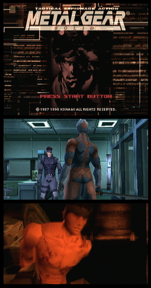Let’s begin with a story from Jorge Luis Borges.
There once was a vast empire whose cartographers drew a map so detailed that it covered every inch of the land. The map frayed and flaked as the empire declined, until both the empire and the map had disappeared.
 |
empire, yet Baudrillard asserted that we start with the map and assume the presence of an empire as a way to cope with the fact that no empire exists.
A map is a metaphor—a sign. It implies that something more real than the map exists.
A map can be dangerous. We tend to see what we are prepared to see, and maps prepare our expectations. A traveler might wander for hours when he trusts a flawed map more than directions from the locals.
MGS2 created its form using its medium and three maps—three sets of the player’s expectations. It used the Series Map, wherein the player expected that MGS2 would play and behave like the first Metal Gear Solid. After the Series Map failed, MGS2 used the Scenario Map, wherein the player expected the same set-pieces and catharses that he had encountered in MGS1. At the same time, the game used the Solid Map, wherein the player expected that he would assume the fictional role of MGS1’s hero, Solid Snake.
MGS1 served as the
player’s roadmap, and MGS2 selectively rearranged its familiar
landmarks to confuse the player’s sense of direction. Familiar sights prompted
the player to expect MGS1’s form—a pattern of failure and redemption—but
they didn’t guide him to his expected destinations. Through these
frustrations, the player dramatized the game’s spin upon its central theme. In
form and content, MGS2 asserted that we must not let cultural memories
inform how we act in situations that seem similar to those that first created
our cultural memories.